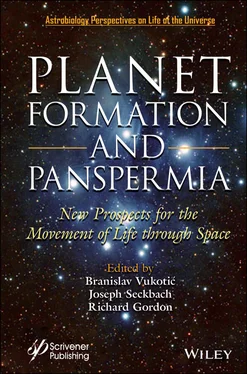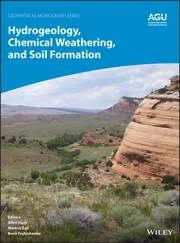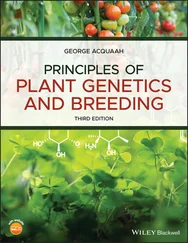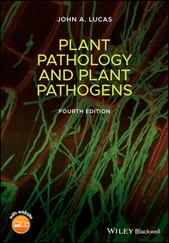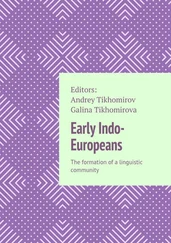10 Chapter 13Figure 13.1 Illustration of how a planetesimal from the planetesimal belt reache...Figure 13.2 Amount of delivered water on planets in TRAPPIST-1 system in percent...
11 Chapter 14Figure 14.1 Diameters of objects that have their escape velocities equal in magn...
1 Chapter 8Table 8.1 Various parameters used for the estimation of the number of captured p...
2 Chapter 10Table 10.1 Comparison between the composition of the lunar (Apollo 15) and terre...
3 Chapter 11Table 11.1 Estimates for the date of LUCA.Table 11.2 Data from [11.5]. Geological names from [11.21] for time points desig...
4 Chapter 12Table 12.1 κ ′ values of magnesite, calcite, siderite, and anhydrite.Table 12.2 κ ′ values of oxides.Table 12.3 κ ′ values of gases.Table 12.4 κ ′ values of primordial atmospheres.
5 Chapter 13Table 13.1 Abundance of 18 most abundant elements relative to H, taken from [13....Table 13.2 List of volatile materials for C, S, and M types of asteroids.
1 v
2 ii
3 iii
4 iv
5 xi
6 xii
7 xiii
8 xiv
9 1
10 3
11 4
12 5
13 7
14 8
15 9
16 10
17 11
18 12
19 13
20 14
21 15
22 16
23 17
24 18
25 19
26 20
27 21
28 22
29 23
30 24
31 25
32 26
33 27
34 28
35 29
36 30
37 31
38 32
39 33
40 34
41 35
42 36
43 37
44 38
45 39
46 40
47 41
48 42
49 43
50 44
51 45
52 46
53 47
54 48
55 49
56 50
57 51
58 53
59 55
60 56
61 57
62 58
63 59
64 60
65 61
66 62
67 63
68 64
69 65
70 66
71 67
72 68
73 69
74 70
75 71
76 72
77 73
78 74
79 75
80 76
81 77
82 78
83 79
84 80
85 81
86 82
87 83
88 84
89 85
90 86
91 87
92 88
93 89
94 90
95 91
96 92
97 93
98 94
99 95
100 96
101 97
102 98
103 99
104 100
105 101
106 102
107 103
108 104
109 105
110 106
111 107
112 108
113 109
114 110
115 111
116 112
117 113
118 114
119 115
120 116
121 117
122 119
123 120
124 121
125 122
126 123
127 124
128 125
129 127
130 128
131 129
132 130
133 131
134 132
135 133
136 134
137 135
138 136
139 137
140 138
141 139
142 140
143 141
144 142
145 143
146 144
147 145
148 146
149 147
150 149
151 150
152 151
153 152
154 153
155 154
156 155
157 156
158 157
159 158
160 159
161 160
162 161
163 162
164 163
165 164
166 165
167 166
168 167
169 168
170 169
171 170
172 171
173 172
174 173
175 174
176 175
177 176
178 177
179 178
180 179
181 180
182 181
183 182
184 183
185 184
186 185
187 186
188 187
189 188
190 189
191 190
192 191
193 192
194 193
195 195
196 196
197 197
198 198
199 199
200 200
201 201
202 202
203 203
204 204
205 205
206 206
207 207
208 208
209 209
210 210
211 211
212 212
213 213
214 214
215 215
216 216
217 217
218 218
219 219
220 220
221 221
222 222
223 223
224 224
225 225
226 226
227 227
228 228
229 229
230 230
231 231
232 232
233 233
234 234
235 235
236 236
237 237
238 238
239 239
240 240
241 241
242 242
243 243
244 244
245 245
246 246
247 247
248 248
249 249
250 251
251 252
252 253
253 254
254 255
255 256
256 257
257 258
258 259
259 260
260 261
261 262
262 263
263 264
264 265
265 267
266 269
267 270
268 271
269 272
270 273
271 274
272 275
273 276
274 277
275 278
276 279
277 280
278 281
279 282
280 283
281 284
282 285
283 286
284 287
285 288
286 289
287 290
288 291
289 292
290 293
291 294
292 295
293 296
294 297
295 298
296 299
297 300
298 301
299 302
300 303
301 304
302 305
303 306
304 307
305 308
306 309
307 310
308 311
309 312
310 313
311 314
312 315
313 316
314 317
315 318
316 319
317 320
318 321
319 322
320 323
321 324
322 325
323 326
324 327
325 328
326 329
327 330
328 331
329 332
330 333
331 334
Scrivener Publishing100 Cummings Center, Suite 541J Beverly, MA 01915-6106
Astrobiology Perspectives on Life of the Universe
Series Editors: Richard Gordon and Joseph Seckbach
In his 1687 book Principia , Isaac Newton showed how a body launched atop a tall mountain parallel to the ground would circle the Earth. Many of us are old enough to have witnessed the realization of this dream in the launch of Sputnik in 1957. Since then our ability to enter, view and understand the Universe has increased dramatically. A great race is on to discover real extraterrestrial life, and to understand our origins, whether on Earth or elsewhere. We take part of the title for this new series of books from the pioneering thoughts of Svante Arrhenius, who reviewed this quest in his 1909 book The Life of the Universe as Conceived by Man from the Earliest Ages to the Present Time . The volumes in Astrobiology Perspectives on Life of the Universewill each delve into an aspect of this adventure, with chapters by those who are involved in it, as well as careful observers and assessors of our progress. Guest editors are invited from time to time, and all chapters are peer-reviewed.
Publishers at Scrivener Martin Scrivener ( martin@scrivenerpublishing.com) Phillip Carmical ( pcarmical@scrivenerpublishing.com)
Planet Formation and Panspermia
New Prospects for the Movement of Life through Space
Edited by
Branislav Vukotić
Astronomical Observatory, Belgrade, Serbia
Richard Gordon
Gulf Specimen Marine Laboratory & Aquarium, Panacea, FL, USA and Wayne University, Detroit, MI, USA
and
Joseph Seckbach
The Hebrew University of Jerusalem, Israel

This edition first published 2021 by John Wiley & Sons, Inc., 111 River Street, Hoboken, NJ 07030, USA and Scrivener Publishing LLC, 100 Cummings Center, Suite 541J, Beverly, MA 01915, USA
© 2021 Scrivener Publishing LLC
For more information about Scrivener publications please visit www.scrivenerpublishing.com.
Читать дальше
